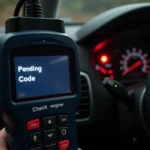The OBD2 port, a staple in vehicles since 1996, is a valuable tool for mechanics and car enthusiasts alike. It provides a wealth of information about your vehicle’s health and performance. But what happens when you need to bypass the OBD2 system? While “how to bypass obd2” is a common search query, it’s crucial to understand the implications and potential risks involved.
Understanding the OBD2 System and Why People Bypass It
Before diving into bypassing methods, let’s clarify why someone might want to bypass their OBD2 system in the first place. Some common reasons include:
- Disabling Check Engine Light: A persistent Check Engine Light, especially for minor issues, can be frustrating. Bypassing might seem like a quick fix but often masks underlying problems.
- Emissions Testing: In some cases, individuals might attempt to bypass the system to pass emissions tests, although this is illegal and unethical.
- Troubleshooting: Experienced mechanics might bypass certain sensors temporarily for diagnostic purposes.
Important Note: It’s crucial to remember that tampering with emissions systems is illegal in many jurisdictions. Additionally, bypassing the OBD2 system can have unintended consequences for your vehicle’s performance and safety.
Common OBD2 Bypass Methods and Their Risks
While we do not condone illegal activities, understanding common bypass methods sheds light on the issue. Here are a few examples:
- Oxygen Sensor Simulators: These devices trick the ECU into thinking the oxygen sensor is functioning correctly, even if it’s not.
- ECU Remapping/Flashing: This involves modifying the vehicle’s Engine Control Unit (ECU) software to ignore certain sensor readings.
- Wire Splicing: Some individuals resort to manipulating the wiring harness to bypass specific sensors, which is highly risky.
Risks Associated with Bypassing:
- Further Engine Damage: Ignoring a Check Engine Light can lead to more severe and costly engine problems down the line.
- Failed Emissions Tests: Tampering with emissions systems will likely result in failing emissions tests, leading to fines and registration issues.
- Voided Warranty: Modifications to your vehicle’s emissions system can void your warranty, leaving you responsible for expensive repairs.
Safe and Legal Alternatives to Bypassing OBD2
Instead of resorting to risky bypass methods, consider these safe and legal alternatives:
- Proper Diagnosis and Repair: Address the root cause of the Check Engine Light by having a qualified mechanic diagnose and repair the issue.
- OBD2 Code Readers: Invest in a reliable OBD2 code reader to understand the specific problem triggering the warning light.
- Regular Vehicle Maintenance: Adhering to your vehicle’s recommended maintenance schedule can prevent many issues that trigger the Check Engine Light.
When OBD2 Bypass Might Be Necessary
While we strongly advise against tampering with your vehicle’s emissions system, there are rare instances where bypassing might be necessary for specific repairs or modifications. However, this should only be performed by qualified professionals who understand the implications and potential risks.
Conclusion
Attempting to bypass your OBD2 system is a risky proposition with potentially serious consequences. Instead of looking for shortcuts, focus on understanding and addressing the root cause of any issues with your vehicle.
By investing in a quality OBD2 scanner, you can gain valuable insights into your vehicle’s health and make informed decisions about its maintenance. Remember, a properly functioning OBD2 system is crucial for ensuring your vehicle’s optimal performance, fuel efficiency, and adherence to emissions standards.


